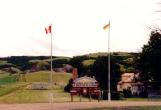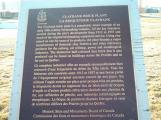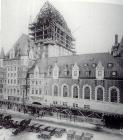1
The Gate at the east entrance to the Claybank Brick Plant National Historic Site.1 December 2003
Claybank Brick Plant Site

2
ALITTLE
BRICK PLANT
IN THE
MIDDLE
OF
NOWHERE
4
WELCOME!!TO THE CLAYBANK
BRICK PLANT STORY:
FROM CLAY TO KILN
5
Claybank Brick Plant was designated a National Historic Site in 19948 December 2003
Claybank Brick Plant Site

6
The Claybank Brick Plant is a Provincial Historic Site as well as a National Historic Site designated in 1994.The bricks produced here were mainly refractory brick; 'refractory' meaning able to withstand high heat. For example, steel will melt at around 1800 degrees F, our high grade bricks will not deteriorate until a temperature of around 3300 degrees F is reached! Claybank Brick Plant also produced Facebrick that was available for building construction until the 1960's.
The Claybank Brick Plant Site was designated as a National Historic Site for many reasons as is made evident by the text on our designation plaque:
The Claybank Brick Plant is a remarkably intact example of an early 20th century brickmaking complex. All the key structures erected during the site's development from 1912 to 1937 and much of the original brickmaking equipment survive. Using clay mined on site for most of its products, the plant became a major manufacturer of domestic clay firebrick and other refractory products for the railway, oil refining, power and metallurgical industries. The distinctive buff-coloured facebrick that it also produced can be found on buildings across the Prairies and as far east as Quebec.
7
In addition to the characteristics featured on our Designation Plaque we also like to highlight some other claims to fame:8
The Chateau Frontenac National Historic Site in Quebec City1 December 2003
Claybank Brick Building and Patterns

9
High quality Facebrick was used in some of Canada's most prominent government and commercial structures. In the 1920's the central tower of a CP Hotel The Chateau Frontenac, in Quebec City, was faced with Claybank Tee Pee Moka Brick. The Chateau Frontenac is also a Canadian National Historic Site!10
Architectural drawing of the Chateau Frontenac Hotel another National Historic Site.1920
Claybank Brick Building and Patterns

11
Chateau Frontenac tower construction, 1920's, with face brick from Claybank.1920
Claybank Brick Building and Patterns



